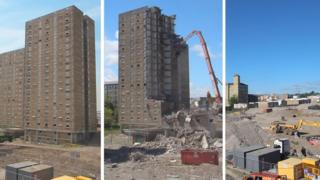
Image copyright
Rhodar
Footage of buildings being flattened in a noisy demolition may be a popular feature of local TV news reports, but architects say such structures should be protected – to fight climate change.
They say property owners should be incentivised to upgrade draughty buildings, not just knock them down.
That is because so much carbon is emitted by creating the steel, cement and bricks for new buildings.
The campaign by the Architects’ Journal is backed by 14 Stirling Prize winners
In the past there was a lot of debate about whether it was better for the climate to demolish an old energy-hungry building and build a well-insulated replacement.
But this is now widely considered a serious mistake because of the amount of carbon emitted during the construction of the new building.
The Royal Institute of Chartered Surveyors (RICS) estimates that 35% of the lifecycle carbon from a typical office development is emitted before the building is even opened. It says the figure for residential premises is 51%.
These calculations suggest it will be decades before some new buildings pay back their carbon debt by saving more emissions than they created – and these are decades when carbon must be sharply reduced.
Media playback is unsupported on your device
The Architects’ Journal has now given evidence to the Commons Environmental Audit Committee (EAC) on the difference between operational emissions from heating and cooling a building and embodied emissions from creating construction materials.
It wants the government to change the VAT rules which can make it cheaper to rebuild than to refurbish a standing building.
Architects’ Journal editor Will Hurst said: “This staggering fact has only been properly grasped in the construction industry relatively recently. We’ve got to stop mindlessly pulling buildings down.”
He said VAT on refurbishment, repair and maintenance should be cut from 20% to zero to match the typical rate for new-build.
He continued: “It’s crazy that the government actually incentivises practices that create more carbon emissions. Also, if you avoid demolition you make carbon savings right now, which we really need.
“In the past the government argued that the EU would forbid zero VAT on renovation – but they can’t use that excuse now.”
And Alex Green, from the British Property Federation, said that sometimes the different VAT level is the key factor in determining whether a building is felled or saved for a new purpose.
Image copyright
Getty Images
Treasury Minister Jesse Norman previously told MPs that property owners already benefit from a reduced VAT rate on residential construction under certain conditions.
He said: “Going further would be very expensive: reducing VAT on all property renovation, repairs and improvements would cost the Exchequer approximately £6bn per year.
“The government has no plans to review the VAT treatment of construction.”
What’s more, ministers recently said they would ease planning rules for owners wanting to demolish offices and replace them with new-build homes.
Mr Hurst has urged them to rethink that plan. He suggested the Treasury could raise the tax on new-build projects to compensate for tax reductions from refurbished buildings.
He also suggested planning guidance should create a bias toward refurbishment.
The Architects’ Journal evidence has been reviewed by the EAC. Its chair, Philip Dunne MP, told BBC News: “Prioritising retrofitting can offer huge benefits.
“It enhances energy efficiency and boosts skills and green jobs quickly in the UK. It will be a crucial component for us to move to a low carbon economy.”
The EAC will report its findings on the issue in the coming months.
Follow Roger on Twitter.
Read MoreFeedzy


